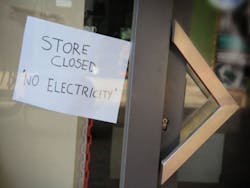With power outages becoming a routine worry for many Californians, several groups last week pushed state regulators to act quickly on microgrid incentives — which are now more than a year in the making.
“This program was designed and decided in early 2021, yet parties have spent months debating the implementation details,” said the Microgrid Equity Coalition, which includes California Environmental Justice Alliance, Sierra Club, The Climate Center, Vote Solar, and the Microgrid Resources Coalition. “During this time, wildfires and public safety power shut-offs persist, and vulnerable communities still lack funding to deploy needed community microgrids.”
The request came in the group’s filing before the California Public Utilities Commission in a multi-year proceeding designed to support microgrid development (Rulemaking 19-09-009). The commission has launched a range of short- and long-term initiatives to achieve the goal.
The $200 million microgrid incentive program, which would help fund community, local and tribal microgrids, won approval in concept in January 2021. But the commission is still working on application requirements, scoring and other grant program details.
Late last year, the state’s investor-owned utilities proposed their ideas for the program. More recently, the commission staff put forward their proposal.
Projects could take years
The County of Los Angeles also urged the commission to move faster, noting that it’s likely to take years to get microgrid projects up and running once the incentive program is approved.
“The state cannot afford any unnecessary delays to the implementation of the MIP [microgrid incentive plan], especially during the current global energy crisis. The February 2022 United Nations report, Spreading like Wildfire: The rising Threat of Extraordinary Landscape Fires, estimates that the likelihood of catastrophic wildfire events could rise by up to 57% by 2100 if carbon emissions are not reduced,” the county said in its filing.
Meanwhile, various parties called for modifications to the proposal.
Community organizations neglected?
The Microgrid Equity Coalition said it will be difficult for disadvantaged communities to participate because no money is made available for community based organizations to hire technical help to undertake the application process.
Community based organizations are already underrepresented in community microgrid development, according to the coalition.
“In our review of nearly 100 community microgrids in California, almost none of the projects are managed by community-based organizations, which have critical knowledge of the needs of disadvantaged communities,” the coalition said.
The coalition also criticized the grant scoring system proposed by the utilities, saying it awards higher scores to communities with greater means.
Los Angeles county said many low-income communities would find it too burdensome to complete a business plan to receive the grant and that the action is redundant given local governments’ review process for capital projects.
“Microgrids are a major civic investment with potential life or death consequences for community members impacted by outages. Communities investing in microgrids will perform appropriate due diligence and ensure projects achieve completion,” the county said.
Rural County Representatives of California praised an aspect of the plan that would offer ‘heat maps’ to show where microgrids would be valuable, based on public safety power shut-offs, a 10-year historical review and annual reliability reports.
But they asked that utilities develop guides to go along with the maps to help stakeholders and the general public understand where microgrids — versus another resilience solution — are appropriate.
Fast trip can mean long outages
The county group also urged that the commission require that the maps show the locations of fast trip outages.
“This year, there have already been over 590 outages impacting over 510,000 PG&E customers (478,000 in June alone). These are not brief outages. Most customers have to wait about 6.5 hours before power is restored: nearly a full school or work day. It took between 17-57 hours before service was restored on 47 circuits. What’s worse is that these outages are frequently recurring,” the county group said.
The CPUC is seeking reply comments on the microgrid incentives by August 19 and has set 2022 for the launch of the program.
Track news about microgrid incentives. Subscribe to the free Microgrid Knowledge Newsletter.







